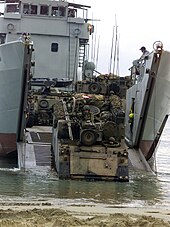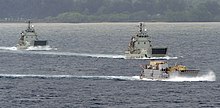
The Papua New Guinea Defence Force (PNGDF) is the military organisation responsible for the defence of Papua New Guinea. It originated from the Australian Army land forces of the territory of Papua New Guinea before independence, coming into being in January 1973 and having its antecedents in the Pacific Islands Regiment. The PNGDF is a small force, numbering around 3,600 personnel, and consists of a Land Element, an Air Element and a Maritime Element. It is a joint force tasked with defending Papua New Guinea and its territories against external attack, as well as having secondary functions including national-building and internal security tasks.
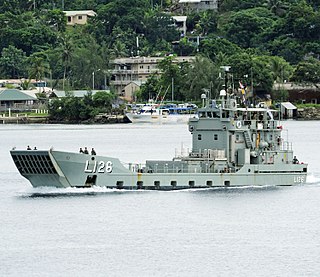
HMAS Balikpapan was the lead ship of the Balikpapan class of heavy landing craft (LCH). Ordered in 1969, Balikpapan entered service with the Australian Army Water Transport Squadron in late 1971. After this, the decision to place all seagoing Army vessels under the control of the Royal Australian Navy (RAN) saw Balikpapan transferred and commissioned in 1974; the last of the eight-vessel class to enter RAN service. Balikpapan was placed in reserve in 1985, but was reactivated three years later. During late 1999 and early 2000, the vessel was part of the INTERFET peacekeeping taskforce, and made additional deployments to East Timor in 2001 and 2006. On 12 December 2012, Balikpapan was retired from RAN service.

HMAS Betano was a Balikpapan-class heavy landing craft operated by the Royal Australian Navy (RAN).

HMPNGS Buna is a Balikpapan-class heavy landing craft operated by the Papua New Guinea Defence Force (PNGDF). Prior to 1974, the vessel was called HMAS Buna and was operated by the Royal Australian Navy (RAN).

HMPNGS Lakekamu is Balikpapan-class landing craft heavy (LCH) operated by the Maritime Operations Element of the Papua New Guinea Defence Force (PNGDF). The vessel was one of eight built for the Royal Australian Navy (RAN) in the 1970s, and was commissioned into the RAN as HMAS Labuan in March 1973. Labuan was decommissioned in November 2014. She was transferred to the PNGDF for use as a training ship and was commissioned as HMPNGS Lakekamu in December 2014.
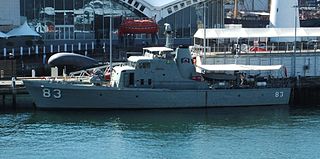
HMAS Ladava was an Attack-class patrol boat of the Royal Australian Navy (RAN). It was named after the small village of Ladava situated on the shore of Milne Bay in Alotau District, Papua New Guinea. Completed in 1968, the vessel was one of five assigned to the RAN's Papua New Guinea (PNG) Division. The patrol boat was transferred to the Papua New Guinea Defence Force in 1974 as HMPNGS Ladava. The patrol boat was decommissioned in 1988, although her fate is unknown.

HMAS Madang, named for the settlement of Madang in New Guinea, was an Attack-class patrol boat of the Royal Australian Navy (RAN). Completed in 1968, the vessel was one of five assigned to the RAN's Papua New Guinea (PNG) Division. The patrol boat was transferred to the Papua New Guinea Defence Force in 1974 as HMPNGS Madang. She was decommissioned in 1989.
HMPNGS Salamaua is a Balikpapan-class heavy landing craft operated by the Papua New Guinea Defence Force (PNGDF). Prior to 1974, the vessel was called HMAS Salamaua and was operated by the Royal Australian Navy (RAN).
The Royal Australian Navy, although a significant force in the Asia-Pacific region, is nonetheless classed as a medium-sized navy. Its fleet is based around two main types of surface combatant, with limited global deployment and air power capability. However, in 2009, a white paper, Defending Australia in the Asia Pacific Century: Force 2030, was produced by the Australian government which set out a programme of defence spending that will see significant improvements to the RAN's fleet and capabilities. In recent times, Australia released its Surface Fleet Review in 2024, which analyses the future of the RAN and shows what the Government will procure.
Two ships of the Royal Australian Navy have been named HMAS Labuan after the World War II amphibious landings at Labuan:
Two ships of the Royal Australian Navy have been named HMAS Tarakan after the town of Tarakan in Borneo and the Allied recapture of this town in 1945.

HMAS Wewak was the fifth ship of the Balikpapan class of heavy landing craft operated by the Royal Australian Navy (RAN).

Walkers Limited was an Australian engineering company, based in Maryborough, Queensland. It built ships and railway locomotives. The Walkers factory still produces railway locomotives and rolling stock as part of Downer Rail.
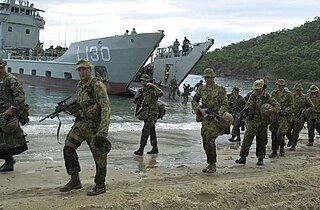
The Royal Australian Navy and Australian Army have operated 29 amphibious warfare ships. These ships have been used to transport Army units and supplies during exercises and operational deployments.

BRP Ivatan (LC-298) is a Balikpapan-class heavy landing craft operated by the Philippine Navy. One of eight vessels built by Walkers Limited for the Royal Australian Navy (RAN), the ship was commissioned into Australian service in 1973 as HMAS Brunei. During her RAN career, Brunei visited Lord Howe Island, was deployed post-Cyclone Tracy as part of Operation Navy Help Darwin, performed coastal surveys of northern Australia and Papua New Guinea, and served as part of the INTERFET peacekeeping taskforce.

BRP Batak (LC-299) is a Balikpapan-class heavy landing craft operated by the Philippine Navy. One of eight vessels built by Walkers Limited for the Royal Australian Navy (RAN), the ship was commissioned into Australian service in 1973 as HMAS Tarakan. During her RAN career, Tarakan was deployed post-Cyclone Tracy as part of Operation Navy Help Darwin, undertook various surveying operations, was placed in reserve between 1985 and 1988, relocated an overpopulation of Tridacna gigas clams, was part of the INTERFET peacekeeping taskforce, and participated in a Pacific Partnership humanitarian deployment.
BRP Waray (LC-288) is a heavy landing craft of the Philippine Navy. From 1972 to 2012, it was known as HMAS Betano and served the Royal Australian Navy. Betano was decommissioned in December 2012 and stored until it was sold by the Australian government to the Philippine Navy to assist in improving the country's humanitarian and disaster relief capabilities.
The BRP Agta (LC-290) is a landing craft heavy of the Philippine Navy. From 1972 to 2012, it was known as HMAS Balikpapan and served the Royal Australian Navy. It was decommissioned in December 2012, was stored until it was sold by the Australian government to the Philippine Navy to assist in improving the country's Humaritarian and Disaster Relief capabilities.
The BRP Iwak (LC-289) is a heavy landing craft of the Philippine Navy. From 1972 to 2012, it was known as HMAS Wewak and served the Royal Australian Navy. It was decommissioned in December 2012, was stored until it was sold by the Australian government to the Philippine Navy to assist in improving the country's Humaritarian and Disaster Relief capabilities.

HMPNGS Seeadler (P03) is one of four Pacific Forum patrol vessels operated by the Papua New-Guinea Defence Force.

